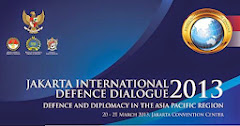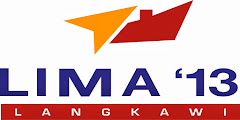Indonesian Defence Industry
 Prototype of short range cruise missile : powered by Austrian turbojet engine (photo : Defense Studies)
Prototype of short range cruise missile : powered by Austrian turbojet engine (photo : Defense Studies)Like many Asian countries, Indonesia has worked hard to establish a defence industry, particularly since 1978. The Pindad small-arms factory was established in 1920 by a German company, but it has now progressed to armoured-vehicle production. PT Pindad has developed the Panser 6x6 Pindad that is inspired by the French VAB. In 1976 the aerospace company PT Nurtanio (now PT Dirgantara) was established, and one of its stars is the CN-235 transport aircraft. It is in Indonesian service, as well as being exported overseas. In terms of ships, PT PAL has launched the first of two Makassar-class LPDs with help from South Korea. Based on its commercial shipbuilding experience, PT PAL has also designed its own 35,000-ton helicopter carrier ship that accommodates six helicopters on its 190m-long hull. Design work has been completed, and it awaits the procurement phase. Local ship production also includes patrol craft and OPVs, but so far production levels are not enough to meet critical requirements.
On 7 March 2007, the government declared it was allocating $866 million to acquire equipment from local defence companies under a strategic programme. Since local industry is not able to produce all the equipment required, this involves utilising overseas companies. Faced with the current economic crisis, PT Dirgantara joined PT PAL in asking the government and private sector for credit to secure short-term stability. On 7 April 2009, PT PAL announced it had renegotiated a loan with a government bank to provide security in 2009-10.
Indonesia is developing its own equipment. One noteworthy innovation is a new 250kg GPS-guided bomb with a maximum range of 200km. It is 1.94m long, and tests will take place some time in 2009. Another new product is a 100-150km short-range cruise missile. The 3m-long missile has completed wind tunnel tests and is undergoing further development. Powered by an Austrian 20kgf turbojet engine, it has a cruise speed of around 0.4 Mach.
Diversifying Defence Suppliers
Diversifying Defence Suppliers
 BUK M1 : compete to bid medium range SAM (photo : Pravda)
BUK M1 : compete to bid medium range SAM (photo : Pravda)The embargoes of 1999 made it patently clear that Indonesia needed to diversify its range of defence suppliers. Poland has been one nation that has benefitted from this diversification. The most notable acquisition has been the Kobra Very Short Range Air Defence (VSHORAD) system. Talks began in 2003 with Radwar (part of the Bumar Group) for a system to supplement the Rapier SHORAD. A contract was not signed until 2005 because of difficulties in financing the transaction. In the end, 85 percent of the contract is being funded by a loan from the Polish government. The deal involves enough Kobras to equip two air-defence batteries, including the 3-D S-band Mobile Multibeam Search Radar (MMSR). There are six ZM Tarnow ZUR-23-2KG-1 twin 23mm guns and two missile-equipped Poprad vehicles in each battery. These entered service in November 2007. The Poprad can be positioned up to 40km from the battery command post or MMSR radar thanks to data transmission by RRC-9500 VHF radio. Indonesia bought four Poprad vehicles, 14 ZUR-23-2KG-1 mounts (two for training), and 74 Grom missiles. A second purchase is underway to equip two further batteries.
South Korea represents another new strategic supplier. In 2003, the TNI-AL received an LPD from Korea, this now serves as a hospital ship and disaster relief vessel. Two LPDs of the 125m-long Makassar class have been acquired from South Korea for LPD missions, and two more are under construction at the PT PAL shipyard in Surabaya, with South Korea transferring technology and giving technical assistance. South Korea has offered to upgrade Indonesia’s two 1,300-ton Type 209 submarines for $350 million each, and could offset the sale by buying eight CN-235 aircraft from Indonesia. The KT-1B Korean Basic Trainer was purchased earlier this decade, while a dozen more were ordered in 2006. South Korea is competing with Russia for the sale of two missile frigates, with a decision slated to take place in 2009. Indonesia also needs a highgrade aircraft trainer, with Korea offering its T-50 and China its FTC-2000. No decision has been made on the preferred design yet.
South Korea represents another new strategic supplier. In 2003, the TNI-AL received an LPD from Korea, this now serves as a hospital ship and disaster relief vessel. Two LPDs of the 125m-long Makassar class have been acquired from South Korea for LPD missions, and two more are under construction at the PT PAL shipyard in Surabaya, with South Korea transferring technology and giving technical assistance. South Korea has offered to upgrade Indonesia’s two 1,300-ton Type 209 submarines for $350 million each, and could offset the sale by buying eight CN-235 aircraft from Indonesia. The KT-1B Korean Basic Trainer was purchased earlier this decade, while a dozen more were ordered in 2006. South Korea is competing with Russia for the sale of two missile frigates, with a decision slated to take place in 2009. Indonesia also needs a highgrade aircraft trainer, with Korea offering its T-50 and China its FTC-2000. No decision has been made on the preferred design yet.
 KS-1 : China's product of medium SAM (photo : Ausairpower)
KS-1 : China's product of medium SAM (photo : Ausairpower)Another country Indonesia is drawing close to is China, as it seeks affordable defence equipment. Indonesia and China had strained relations for many years, but as China rises in the international arena, diplomatic and defence ties between the two nations have strengthened. The TNI-AL has opted for the C-802 antiship missile for its locally built FPB57 NAV V large patrol craft. Each Todak-class vessel will receive two C-802 launch canisters. C-802 missiles were test-fired in June 2008, with only one of the two firings being successful. There are question marks over the reliability of these Chinese missiles, so Indonesia is also considering the French MM40 for outfitting its frigates. The TNI-AU and KorMar purchased 26 QW-3 man-portable airdefence missile systems in 2008. This was the first export sale of the QW-3, and apparently China has also been pitching its KS-1A and HQ-7 SAMs in competition with Russia’s Buk- M1 and TorM1. The TNI-AD opted for 18 Giant Bow twin 23mm air-defence guns, and the most recent purchase was that of the TD-2000B air-defence missile system. Probably a lot of arms purchases are being done as barter trades for Indonesian products such as crude oil and gas. Other interesting products for Indonesia are Chinese J-10 and JF-17 fighters.
The Future
 Chengdu J-10 : Indonesia interest with this aircraft (photo : DefenceTalk)
Chengdu J-10 : Indonesia interest with this aircraft (photo : DefenceTalk)The key identifiable problem with the Indonesian military is that it has never been funded to meet the tasks assigned to it. Thus it has resorted to business enterprises to meet shortfalls. This process has reduced the professionalism of the military, and interfered with its ability to fulfil its primary task of defending the nation. Defence Minister Juwono Sudarsono asked for $41 million extra on top of the FY09 budget (approximately $3 billion) that was passed on 6 January 2009. The extra funds were needed for operational readiness, and to support plans to replace Hawk Mk.53 and OV-10 Bronco aircraft.
The military has been reluctant to implement internal reforms of its self-propagated New Paradigm, signaling it does not want to completely give up its socio-political role. A glimpse of the curriculum at the Military Academy is enlightening, with 53 percent of the content devoted to non-military subjects, 22 percent to military subjects and 15 percent to sports. Whereas their main function should be defending the nation, military officers often attend business meetings rather than train their troops in the field. The military is wary of democracy, but so too it is wary of Islamic extremism in case it upsets the state’s stability.
It is not beyond the realm of possibility that in the future the military could seize power from a civilian government in order to protect unity of the state. To prevent such a military coup, the government must be careful to act maturely in developing the country economically and politically, and provide an adequate military budget to modernize equipment. Interestingly, an election is scheduled for 8 July 2009.
On 22 November 2005, the US announced military ties with Indonesia would be restored after a six-year ban on arms sales. The US and Australia are both highly concerned about maritime security and counterterrorism in Southeast Asia, with Indonesia being a linchpin. Military cooperation with such Western nations is vital in developing Indonesia’s military, and there is a lot of room for improvement. In 2007 there were 110 TNI officers training in Australia, whereas only 60 were in the US. The role of the USA and its level of support for the country will prove to be an important part of the equation. It will be interesting to see how the US pursues relations in light of President Obama’s close personal links to the country. He has already made plans for a state visit some time in 2009.
Australia signed a Joint Statement on Defence Cooperation on 12 January 2009, this assuring cooperation under the Lombok Treaty in areas like counterterrorism, maritime security, intelligence, HADR and peacekeeping. Indonesia knows it needs to spend more on its national defence, but herein lies the problem – there is little cash available. The newest challenge facing Indonesia is the credit crunch that will squeeze military spending even further and make bank loans more difficult to achieve. It seems circumstances have conspired yet again to thwart the TNI. (Gordon Arthur)
(Asian Military Review)










Tidak ada komentar:
Posting Komentar